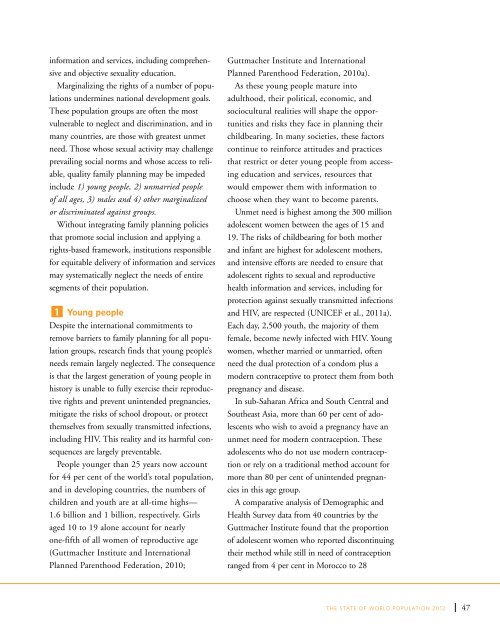State of World Population 2012 - Country Page List - UNFPA
State of World Population 2012 - Country Page List - UNFPA
State of World Population 2012 - Country Page List - UNFPA
Create successful ePaper yourself
Turn your PDF publications into a flip-book with our unique Google optimized e-Paper software.
information and services, including comprehensive<br />
and objective sexuality education.<br />
Marginalizing the rights <strong>of</strong> a number <strong>of</strong> populations<br />
undermines national development goals.<br />
These population groups are <strong>of</strong>ten the most<br />
vulnerable to neglect and discrimination, and in<br />
many countries, are those with greatest unmet<br />
need. Those whose sexual activity may challenge<br />
prevailing social norms and whose access to reliable,<br />
quality family planning may be impeded<br />
include 1) young people, 2) unmarried people<br />
<strong>of</strong> all ages, 3) males and 4) other marginalized<br />
or discriminated against groups.<br />
Without integrating family planning policies<br />
that promote social inclusion and applying a<br />
rights-based framework, institutions responsible<br />
for equitable delivery <strong>of</strong> information and services<br />
may systematically neglect the needs <strong>of</strong> entire<br />
segments <strong>of</strong> their population.<br />
1 Young people<br />
Despite the international commitments to<br />
remove barriers to family planning for all population<br />
groups, research finds that young people’s<br />
needs remain largely neglected. The consequence<br />
is that the largest generation <strong>of</strong> young people in<br />
history is unable to fully exercise their reproductive<br />
rights and prevent unintended pregnancies,<br />
mitigate the risks <strong>of</strong> school dropout, or protect<br />
themselves from sexually transmitted infections,<br />
including HIV. This reality and its harmful consequences<br />
are largely preventable.<br />
People younger than 25 years now account<br />
for 44 per cent <strong>of</strong> the world’s total population,<br />
and in developing countries, the numbers <strong>of</strong><br />
children and youth are at all-time highs—<br />
1.6 billion and 1 billion, respectively. Girls<br />
aged 10 to 19 alone account for nearly<br />
one-fifth <strong>of</strong> all women <strong>of</strong> reproductive age<br />
(Guttmacher Institute and International<br />
Planned Parenthood Federation, 2010;<br />
Guttmacher Institute and International<br />
Planned Parenthood Federation, 2010a).<br />
As these young people mature into<br />
adulthood, their political, economic, and<br />
sociocultural realities will shape the opportunities<br />
and risks they face in planning their<br />
childbearing. In many societies, these factors<br />
continue to reinforce attitudes and practices<br />
that restrict or deter young people from accessing<br />
education and services, resources that<br />
would empower them with information to<br />
choose when they want to become parents.<br />
Unmet need is highest among the 300 million<br />
adolescent women between the ages <strong>of</strong> 15 and<br />
19. The risks <strong>of</strong> childbearing for both mother<br />
and infant are highest for adolescent mothers,<br />
and intensive efforts are needed to ensure that<br />
adolescent rights to sexual and reproductive<br />
health information and services, including for<br />
protection against sexually transmitted infections<br />
and HIV, are respected (UNICEF et al., 2011a).<br />
Each day, 2,500 youth, the majority <strong>of</strong> them<br />
female, become newly infected with HIV. Young<br />
women, whether married or unmarried, <strong>of</strong>ten<br />
need the dual protection <strong>of</strong> a condom plus a<br />
modern contraceptive to protect them from both<br />
pregnancy and disease.<br />
In sub-Saharan Africa and South Central and<br />
Southeast Asia, more than 60 per cent <strong>of</strong> adolescents<br />
who wish to avoid a pregnancy have an<br />
unmet need for modern contraception. These<br />
adolescents who do not use modern contraception<br />
or rely on a traditional method account for<br />
more than 80 per cent <strong>of</strong> unintended pregnancies<br />
in this age group.<br />
A comparative analysis <strong>of</strong> Demographic and<br />
Health Survey data from 40 countries by the<br />
Guttmacher Institute found that the proportion<br />
<strong>of</strong> adolescent women who reported discontinuing<br />
their method while still in need <strong>of</strong> contraception<br />
ranged from 4 per cent in Morocco to 28<br />
THE STATE OF WORLD POPULATION <strong>2012</strong><br />
47
















